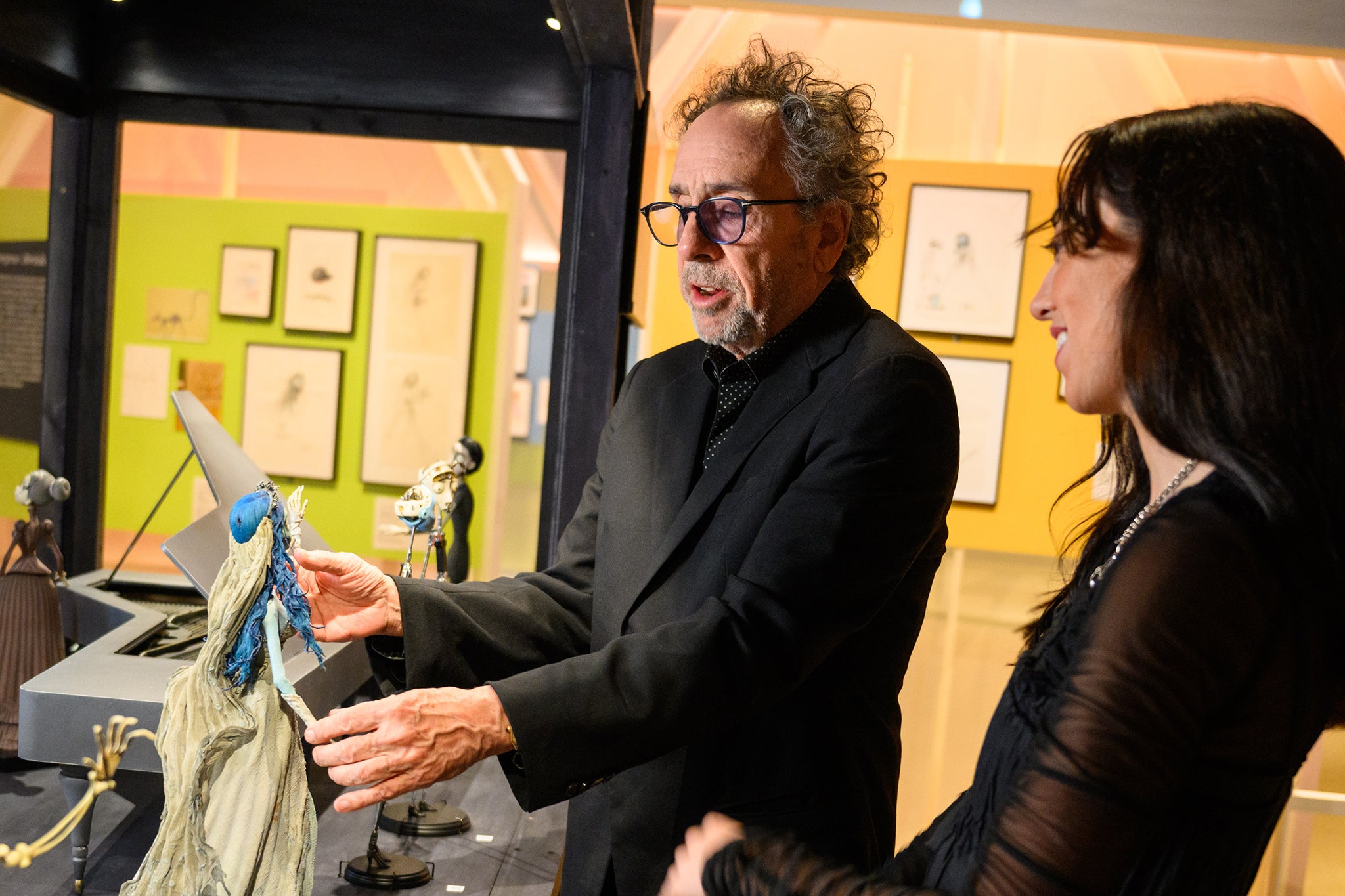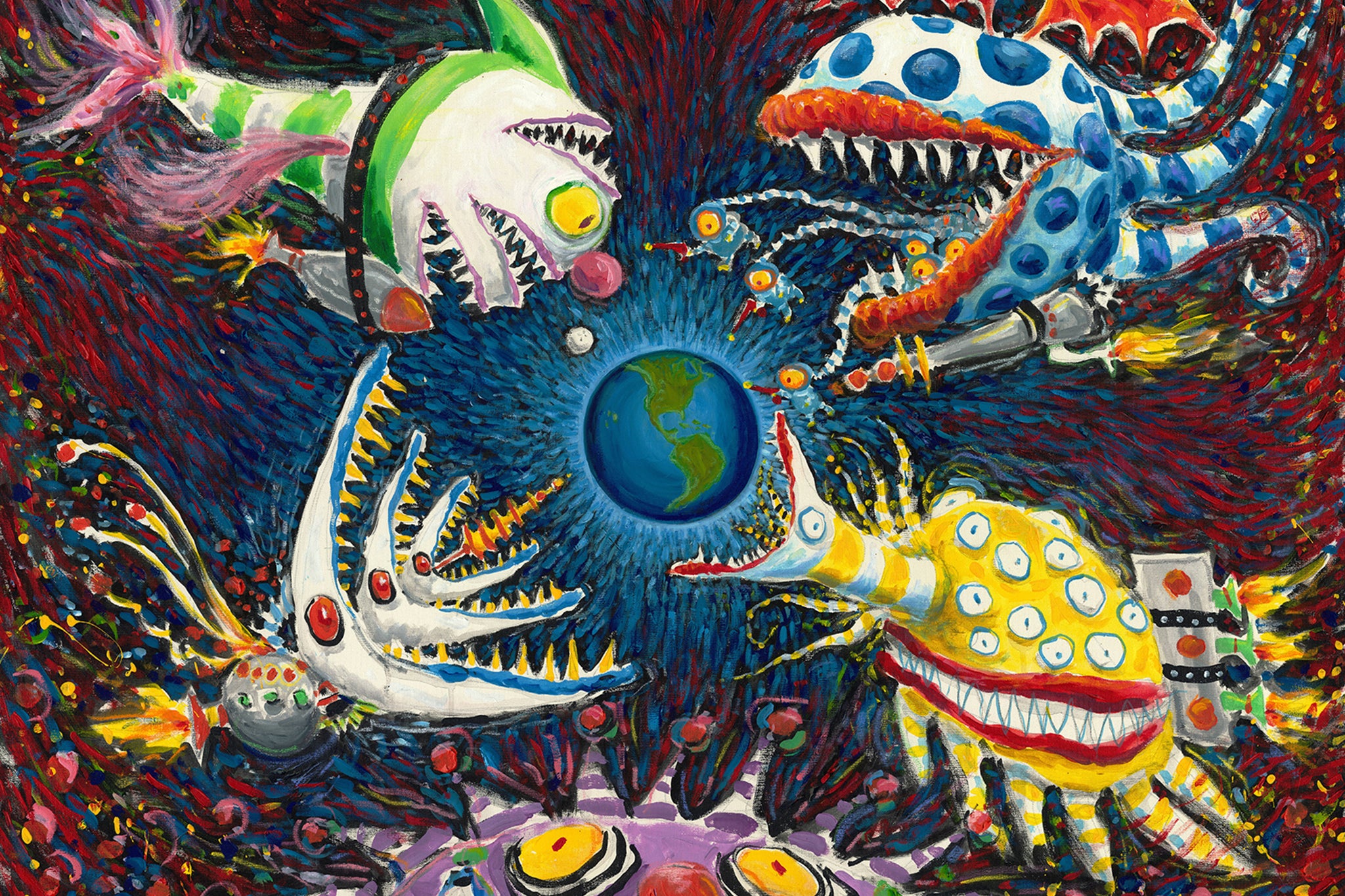Tim Burton and the making of a haven for weirdos
The archives belonging to the celebrated filmmaker behind macabre classics including ‘Beetlejuice’, ‘Batman’ and ‘Edward Scissorhands’ have gone on display at London’s Design Museum. It’s spooky, beautiful, and the exhibition of the year, writes Adam White
Tim Burton has a type. She is lily-white and willowy, with blood-red lips and oversized eyes the shape of almonds. She is, inevitably, covered in cobwebs. This woman – a corpse bride, you might say – is all over The Design Museum’s blockbuster Burton exhibition, drawn across the decades in sketchbooks and on hotel stationery, on napkins and in tear-away notepads. It becomes its own running joke. Yes, here you may bear witness to the literal scissor-hands from Edward Scissorhands, but also look at yet another crude sketch of an incredibly busty undead woman!
The World of Tim Burton does not, then, guide us through one man’s extraordinary evolution over time. Really this eagerly anticipated exhibition, which smashed the museum’s record for advance ticket sales and is running until April 2025, is a celebration of an old motto: if it ain’t broke, don’t fix it.
The show serves as a testament to a filmmaker once strikingly original, who hasn’t been especially novel for a while, but who is still very, very good when it comes to a particular set of motifs. Oddballs! Outsiders! Sex objects for the gothy shadow-dwellers in your life! Few Hollywood studio films have ever spoken to unabashed, unashamed freakiness better than his sensitive Ed Wood, or his two strange, kinky Batman movies. When he’s good, he’s absolutely brilliant. Perhaps The World of Tim Burton is merely a recipient of good timing – if it opened shortly after Burton’s risible 2019 Dumbo re-do, rather than the return-to-form that was September’s Beetlejuice Beetlejuice, goodwill may not have been as forthcoming. Regardless, here we are: the exhibition of the year.
On a lukewarm weekday in Kensington, west London, Burton strides casually into the Design Museum’s central auditorium. He’s more manicured than you might expect, particularly if you remember him as the wild-haired geek from 30 years ago. Today his hair has been tamed into tight curls, his suit is form-fitting, the only real dash of the slightly askew being his swirly black-and-white socks.
“When I was walking around the exhibit, it felt like walking around a weird, beautiful funhouse,” he tells a cluster of assembled journalists. “The lighting, the feng shui or whatever – the flow of it. It made me feel much more calm.” Burton has a bit of a surfer-dude rhythm to his voice – it’s laconic, Keanu-like, deeply Californian. It shouldn’t be too surprising. The 66-year-old was born there, famously finding the identikit houses and sunny malaise of his home city, the Hollywood-adjacent LA suburb of Burbank, deeply repulsive as a youngster. Darkness provided a haven. He began to watch B-movies and films with Vincent Price in them, then decided to make things himself.
The show’s curator Maria McLintock, who joined Burton on stage at the event, added that Vincent (1982), Burton’s early short about a seven-year-old looking to escape his humdrum existence, most succinctly captured the filmmaker’s perspective. “It’s all in there,” she said. “You’ve got the misunderstood outcast, the small boy who wants to be Vincent Price. He likes his sister and his dog and his cats, but he’d rather be hanging out with spiders and bats.”

Vincent and the majority of Burton’s feature films are explored in the new exhibition, which gathers together costumes, props and ephemera from his early life and 40-plus years in cinema. It’s the last stop on the show’s global tour, too, having travelled as far as Japan and Italy since 2014 – though no other city got Michelle Pfeiffer’s torn-apart and crudely stitched-back-together Catwoman costume from his 1992 sequel Batman Returns, which makes an intimidating appearance here. Speaking to the press, Burton suggested a slight detachment from the show so far and a wariness to have it run in London, his adopted home of more than two decades. “I might have thinner skin than I think I do,” he explained. “[The exhibition] almost didn’t become real – it just went to all different places, so it never really became a reality [for me].”
You can understand his reticence. The World of Tim Burton feels very much like an excavation of the filmmaker’s soul, with a recreation of his at-home workspace, personal keepsakes from his archives, and items that were probably never meant to be seen so publicly. There are maquettes from the production of Corpse Bride and his aborted attempt at a Nineties Superman film (Nicolas Cage was intended to star), the dress Jenna Ortega wore for her dance sequence in the first season of the Burton-produced Addams Family spin-off Wednesday, hand-painted gowns from Sleepy Hollow, elaborate art pieces inspired by his work.

But the real highlights are the private doodles that cover two walls of the exhibition, full of zombies, silliness and baffling in-jokes. There’s a napkin depicting two people hanging from a tree on a sunny day, another chesty woman next to the words “Lost Vegas”, “tee hee” scrawled above a man on fire. On sketch paper from the Ritz Paris, Burton has drawn in black, red and blue pencil dead men and bunny rabbits serving booze.
There is a child-like whimsy to all of this. Burton loves a morbid gag and a bit of cut-and-paste – an early sketch of an alien for his 1996 comedy Mars Attacks! has shiny cardboard stuck on beneath an extra-terrestrial head that resembles an upside-down scrotum. He seems to be a fan of the glitter pen.
That naivety might speak to his cross-generational appeal. Burton’s work has always fused innocence with a barbed naughtiness, and often so discreetly that it typically flies over the heads of the young. Batman Returns, for instance, is on one level a traditional story of a superhero fighting villains eager to take over a metropolitan city. But watch it when you’re not nine or 10, and it becomes a wildly outré exercise in body horror, sexual dysfunction and BDSM. Has anyone in any movie ever been quite as violently and erotically charged as Pfeiffer’s increasingly unhinged Catwoman?
“I never did know who my audience was,” Burton told the press. “Even from the beginning, people would either go, ‘Oh, you’re making it for kids’ or ‘Oh no, that’s definitely not for kids’.” He was told that 1994’s macabre musical The Nightmare Before Christmas, which he produced and was based on his early poetry, was going to be disliked by children, and that Batman Returns was “too scary” for younger audiences. “I was always confused,” he continued. “I never really targeted anything, and was always surprised whenever kids or adults or anybody liked it.”

Though he avoided outright regret over any projects, Burton did nod to his creative fallow years, suggesting he feels “re-energised” in the wake of the back-to-back creative and commercial hits that were Wednesday and his Beetlejuice sequel. Yet the exhibition itself doesn’t seem to separate his duds and his classics – sure, his horrid remake of Planet of the Apes doesn’t feature, but then again Ed Wood doesn’t either, as far as I could tell.
It’s noticeable, though, that his early pre-production sketches for Dumbo – an experience he compared to a “horrible big circus” from which he “needed to escape” – are blocky, dull and curiously lacking in detail. The elephant himself is little more than a grey blob; the tent he’s in is made up of thick dashes of red and blue paint. The detailed elegance of, say, Burton’s early Edward Scissorhands sketches – with their flamboyant Robert-Smith-from-The-Cure hair and evocative, piercing eyes – is entirely absent.

What a relief, then, that he found his way back. If The World of Tim Burton reminds us of anything, it’s that the filmmaker is one of our greatest living talents – a man whose unconventional approach to storytelling and design became so unusually popular that it became easy to take him for granted. It’s appropriate, also, that the Design Museum is playing host to Burton just as their similarly massive Barbie exhibition is drawing to a close. Think of the two shows as exemplifying – in the most blunt of terms, of course – the duality of man. One is for the world’s shiny people. The other is for the weirdos. And how wonderful it is that we live in a time where we can have both.
The World of Tim Burton is running at London’s Design Museum until 21 April
Join our commenting forum
Join thought-provoking conversations, follow other Independent readers and see their replies
Comments
Bookmark popover
Removed from bookmarks